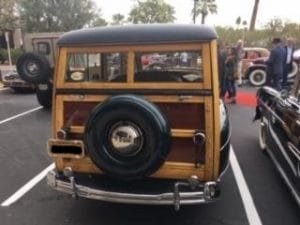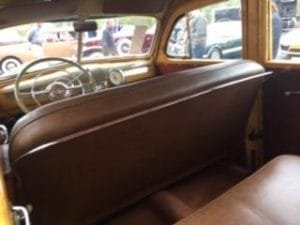Ford Motor Company produced the first woodie wagon in 1929 with it’s Model A. The woodie was quite popular and it’s style lasted about a quarter of a century. The 1947 Ford Super Deluxe Woodie Wagon featured here is a great example of the beauty automakers could add to a vehicle by using finished wood trim. This eight passenger Woodie Wagon is a true classic Ford. From 1929 up to 1951 Ford Motor Company sold the most popular woodie station wagons during those years.

Henry Ford was so confident that the woodie concept would endure he bought hundreds of thousands of acres of woods in the western part of Michigan’s Upper Peninsula.
By 1940, complete wood bodies were being built at Iron Mountain, Michigan and shipped to the Ford assembly plants where they were put on chassis. The vehicle’s body framework was typically maple, birch, mahogany or gum wood panels.
The first woodies were wagons and utility depot hacks. These were vehicles that were used at the time to transport passengers typically to and from railroad stations and hotels. These replaced the wooden horse drawn wagons. It’s a fact that during the first few decades of the twentieth century, the bodies of motorized depot hacks were essentially the same as those made for horse carriages except to lengthen them to fit over truck wheels. While the very first generation of wooden depot hacks were not enclosed, it didn’t take long for automakers and coach builders to build totally enclosed bodies.

While we look at the styling beauty of classic restored woodie wagons, it’s interesting to understand what it takes to build and maintain such an impressive upscale vehicle.
Wood was nothing new to transportation since horse drawn carriages were mainly made of wood. Many people involved in the new motor car industry were previously involved in the carriage building business. Stamped metal was expensive and wood could fill the need early on.
Building a woodie motor vehicle would often take well over one hundred pieces of wood and the building process would be quite time consuming. It was a very labor intensive model to build. The extra costs of production of course would have to be passed on to the buyer. On the other hand, the woodie buyer would have to pay attention to maintenance. Unlike metal, wood can warp and rot over time if not cared for.
The popularity of wood panels on motor vehicles began to wane during the last few years of the 1940’s and into the early 50’s. It became evident to car buyers that maintaining wood and maintaining steel were two different things. A varnished wood panel should receive a regular cleaning and waxing. You want to make certain that the varnish covers well over all pores in the wood. The care of steel obviously being much easier and less expensive to care for.
1947 Ford Woodie Wagon Specifications
Two engines were available for the 1947 Ford Super Deluxe Woodie Wagon. These were a 226 cubic inch straight six and a 239 cubic inch V-8. Horsepower delivered was 90 and 100 respectively.
 Gear boxes were three speed manuals.
Gear boxes were three speed manuals.
Brakes were four wheel hydraulic drums.
Dimensions include a 114.0 inch wheelbase, 196.2 inch overall length, width 73.3 inches.
Ford Motor Company 1947 vehicle production totaled 429,670 units. Out of that number Ford built 4,910 Woodie Wagons.
New car price for the 1947 Ford Super Deluxe Woodie Wagon was $3,500.
See related Auto Museum Online Articles on the links below…
Reference material for this article includes…Famous Ford Woodies: America’s Favorite Station Wagons, 1929-51 by Lorin Sorensen…The Wood…the Cars…the People: 30 Years of the National Woodie Club…Ford Motor Company Archives.
Ford Woodie Wagon Collector Cars
 As mentioned before, Ford invested heavily in producing their popular woodie wagons, For many years they were very popular with upscale families who could afford their price tag.
As mentioned before, Ford invested heavily in producing their popular woodie wagons, For many years they were very popular with upscale families who could afford their price tag.
Numbers built were never but a very small percentage of an automaker’s total production making woodies relatively rare today. These low numbers were mostly due to the vehicles price and the fact that there was less profit per car for the automaker.
The featured vehicle in this article is one of the finest example you’ll come across. This particular 1947 Ford Woodie Super Deluxe sold at auction for well over $100,000.
We find current asking prices for 1947 Ford Woodie Wagons to range from about $50,000 to $75,000. There are a lot of variables to these prices including the condition of the wood panels, originality, restoration, mileage, etc.
(Article and photos copyright Auto Museum Online)
